Vallalar
வள்ளலார்
For more images of Vallalar, click on the picture above.
"We all come from the same Light source (Arut Perum Jothi, also called
clear light). During the process of creation through the elements, the physical body is formed. It is possible for us to reverse the process and make this physical body pure light, here and now, in this plane. We come from the source so we can be the source.
When we express Love, Compassion, and Bliss we are all connected. We are One because those qualities are the qualities of all souls and also the qualities of the Absolute Eternal Grace Light.
There is only one God which is the Absolute Eternal Light, no other form should be worshipped.
There are no castes, no differences of sex...we are all equal.
One should treat all life as he would treat his own life.
One should not believe in scripture but gain his own understanding and knowledge.
All religions, philosophies, and organizations are false; they are only hiding the truth.
One should ask, “Do I accept death and aging?” If you do not accept this, then do something about it and follow my example."
Vallalar is one of the greatest examples in history of what is possible in the field of meditation and kundalini evolution. It is well documented and not ancient knowledge as is the case with Jains and Buddhism, where fact and fiction become blurry. However, only a few were ready to receive this gift, if any at all. In Vallalar's words: "Not even my closest devotees have understood what I am talking about." But history repeats itself as this has been the case with almost all the great spiritual masters in history - for example, Jesus and Mahavatar Babaji. If the message and teachings were really understood, then there would be many more saints and masters reaching those high states of meditation. It is also said that Vallalar closed the Gnana Sabai temple in his last days and stopped the so-called Suddha Sanmarga movement because of the same reasons.
Let it also be clear that he was certainly not the only one who reached the state of Gnana Deham, otherwise called the rainbow body or simply the light body. In history, there are many examples of people dissolving into light, however, these are mostly known among practitioners of Longde and Managede of Dzogchen Buddhism and Jains. The great thing about Vallalar is that it is relatively recent and well documented, and there is even a real picture available from him as shown below.

Now the story goes that in his last days, he locked himself up in a room with the instruction never to open the door. However, after the police did open the door eventually, there was nobody there. One could argue that he simply dematerialized and rematerialized somewhere else in solitude, or even more sinister, that he simply walked away while the people around him were asleep. Why do I not believe this is the case? It is because of the incredible energy around the room where he attained the state of Gnana Deham. The vibration and power are unlike anything I have ever experienced. Keep in mind I have been visiting many Jeeva Samadhis and saints over the past years to compare. This is also one of the main reasons why I do not believe that the Nayanmars came even close to this state as the places where they supposedly dissolved into light have no energy whatsoever, and the pictures indicate that they were burned alive instead of dissolving as light, otherwise known as Spontaneous Human Combustion (SHC). The exception being Manickavasagar, but he was officially no Nayanmar.
So instead of looking into history for his teachings, it would be more beneficial to look at how he did it himself and what methods he used. As you will find out below, it was not mere compassion and vegetarianism that did the trick. In Vallalar's words:
"One should ask, “Do I accept death and aging?” If you do not accept this, then do something about it and follow my example."
So let's start with his birthplace - Maruthur, South Arcot district, located near Chidambaram. (Vallalar Thiru Avatara Maruthur Vawri)

Here his father Ramaiah Pillai was a village Munsif, and his mother was Chinnamayar. He was born on October 5, 1823, as the fifth child to this noble couple.
The story goes that once a great Saint came to Chinnamayar for some food. She served him with great respect! Pleased with the service of Chinnamayar, the Saint offered her vibhuti as Prasadam and blessed her, saying, "You shall very soon have a son like me born unto you." It is said that the Saint was Lord Siva himself. After receiving the vibhuti, Chinnamayar had Vallalar as her fifth child!
They named him after Lord Siva as Ramalingam.

Above is a picture of what is now a temple where Ramalingam was born. The exact location was a basement under the temple (stair entrance to the left and right of the picture below) where he was born.
When he was a five-month-old baby, his parents took him to Lord Nataraja's temple in Chidambaram. The five-month-old Ramalingam laughed towards Lord Siva and waved his hands toward the deity. The temple priest assured the parents that the baby was a sacred child of Lord Nataraja.
When Ramalingam was a six-month-old baby, his father passed away. His brothers Sabapathy and Parasuraman took charge of running the family. They settled in Madras after the demise of their father. Ramalingam, at the age of five, was put into school. The elder brother Sabapathy kept teaching him Tamil verses too. Instead of attending school, however, Vallalar passed the time reciting in ecstasy poems written by himself in the temple of Kanthakottam (Madras). Sabapathy was convinced that the child was on a self-destructive path. As a punitive measure, he forbade his wife from giving Ramalingam his daily meal.

His compassionate sister-in-law, however, secretly fed him food out of compassion.
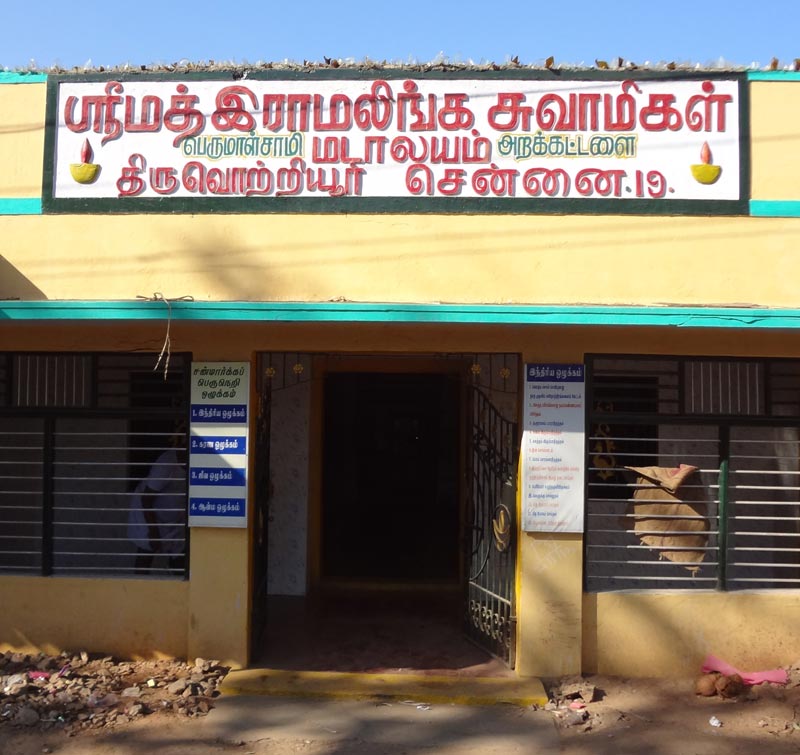
Upon the arrival of the anniversary of their father's death, Sabapathy prepared a meal and invited all of his friends and relatives. Ramalingam, who had not dared to attend, found his sister-in-law waiting for him at the rear door of the house where he arrived secretly late at night. She invited him kindly to take the leftovers of the feast, but seeing how he swallowed the cold and half-eaten food, she started to cry. He asked her the reason for her crying, and she begged him to go to school and study as were the wishes of her brother. Ramalingam agreed only if he would be given a separate room of his own. This was agreed upon, and he was given a small room under the stairs where he placed a mirror with a lighted lamp. With these as aids, he relentlessly meditated, and this was the beginning of the young boy's spiritual journey. The first reward came in the form of a vision of Lord Muruga. In the saint's own words:
"The beauty endowed divine faces six, the illustrious shoulders twelve."

Vallalar's old home
(It is my firm belief that Vallalar was using the mirror in combination with self-inquiry for over 15 years in Chennai, one of the most powerful methods available to kill the ego. I have been doing this type of meditation for over 5 years now and can only say that there are very few things in life that are so direct and powerful to kill the ego as this type of meditation does. That Ramalingam was doing this meditation was also confirmed to me by standing in front of this mirror and recognizing the extreme high energy in the reflection)

Vallalar's mirror located in north Chennai
After that happy event, Vallalar was regularly seen in the temple of Thiruvotriur (Madras), where he recited many hymns before the deity with absolute spontaneity. His own teacher would listen to him and admire his talent and inform his older brother about his wisdom. Sabapathi, who used to give speeches in the house of a philanthropist to gain his living, considered that the time was right for his brother to be his assistant in reading the Scriptures. One day in which Sabapathi felt sick, Ramalinga came alone to the customary place to explain to the people assembled that the study on the Scriptures had to be postponed. However, all those present asked him to substitute for his brother, and he started to speak according to his own knowledge. Then he felt that God's wish was to start his mission in the world, and he did it with a comment about the life of one of the four great Tamil saints (Thirugnana Sambandar).
“O Jnana Sambandar, my noble Sat Guru! You have told me (by inspiration) what, if one gets the experience of the self (uyir anubhavam), will form the basis in which the higher experience of Grace (Arul anubhavam) will come, and in that defectless and noble experience will arise in turn the experience of Suddha Siva anubhavam. O Jnana Sambandar, who as a child of tender age of three years took in happily the milk of Knowledge given by the supreme Shakti, and fostered and developed the path of Truth.”“O my Sat Guru! O Siddha Purusha! O Treasure! O Jnana Sambandar of the famous place Sirkali. You had instructed me thus: 'Transcend each of the states of tatvas (principles of lower manifestation) and reach the unique Paranada state where you will realize the Self (which is the same in all) without your being (the individuality).' This is called Uyir anubhavam. O Guru! You have made me realize the Self in myself, in the said plane of consciousness.”
“O my Sat Guru! O Jnana Sambandar! You have revealed to me by words thus: 'In the realm beyond the unique Paranada (the highest level), it is the experience of Grace (Arul anubhavam) which makes your being (true individual self) become the fearless eternal and infinite Self-existence and also one with Parampara, the global universe within and without, and gives a blissful state beyond description of words.'”
All people were amazed with his eloquence and declared their interest in completing the series of readings. Ramalinga was in agreement with them and people were learning by merely listening to him. This happened around 1835, at the age of twelve. One day a devotee asked Sabapathi to listen to Ramalinga's poems and evaluate for himself how his brother had spiritually progressed. So his brother did secretively and by listening to his small brother he couldn't do anything but consider him like the incarnation of Divine wisdom. From that time Ramalinga was treated with special reverence. To the age of 21 he accustomed to speak freely in the streets, without anything in return for it.
He was obliged to get married despite of his resistance to the idea but never the less accepted a normal married life along with his meditation and speaches.
Not that long after his marriage he moved back to his birthplace near Vadalur where he joined the Tattuvaraya swamigal jeeva samadhi temple where he was made familiar with all the advaita metarials available in Tamil at the time by the swami who was attending the temple. He meditated there for many years and it was this place where the siddhis (perfections) started to show and miracles started to happen.

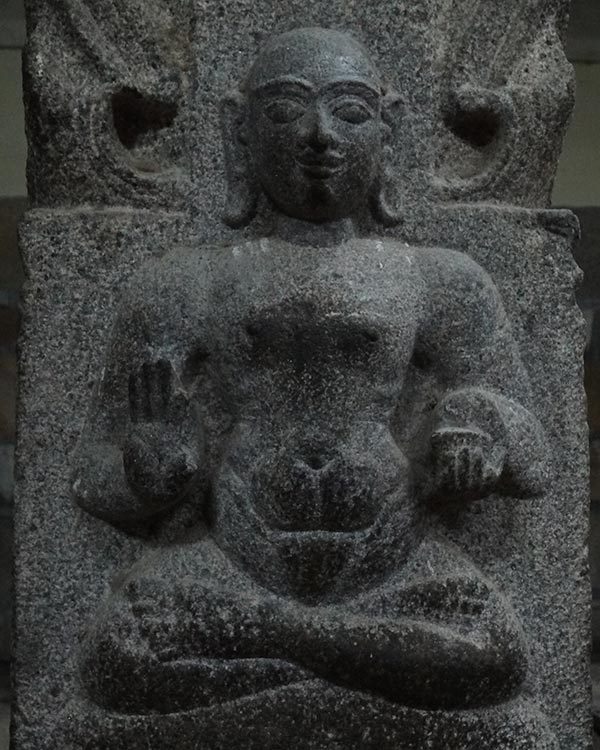
Above is a statue of Tattuvaraya Swamigal. Tattuvaraya was a Tamil saint and poet whom scholars believe flourished in the late 15th century. He was a prolific author who wrote thousands of verses on a wide variety of spiritual topics. He was ‘the first to pour forth advaita philosophy in Tamil’. Prior to his arrival on the Tamil literary scene, advaita texts in Tamil seem to have been translations of, or expositions on, texts composed in Sanskrit.
Below is the Jeeva Samadhi of Tattuvaraya Swamigal in the same temple near Chidambaram.

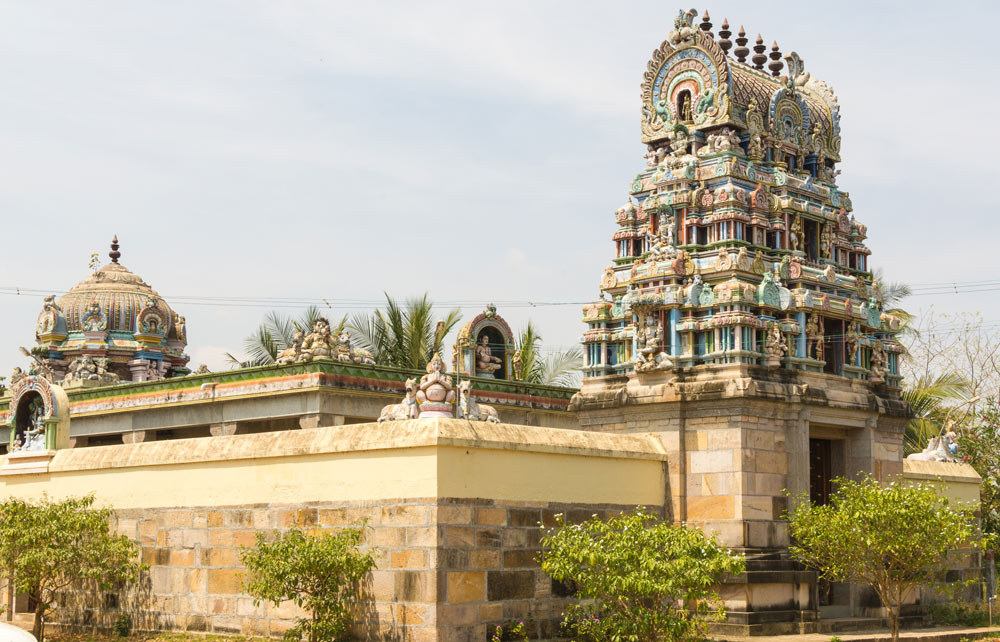
Vallalar visited and received the teachings of Tattuvaraya Swamigal around the time when he moved to Vadalur.
He founded the Dharma Salai on May 23, 1867, a center destined to give hospitality to the fatigued traveler, food to the indigent elders, and medical aid to the patients without resources. Ramalingam was accustomed to give oral teachings to his disciples.

Above and below are pictures of the Dharma Salai.
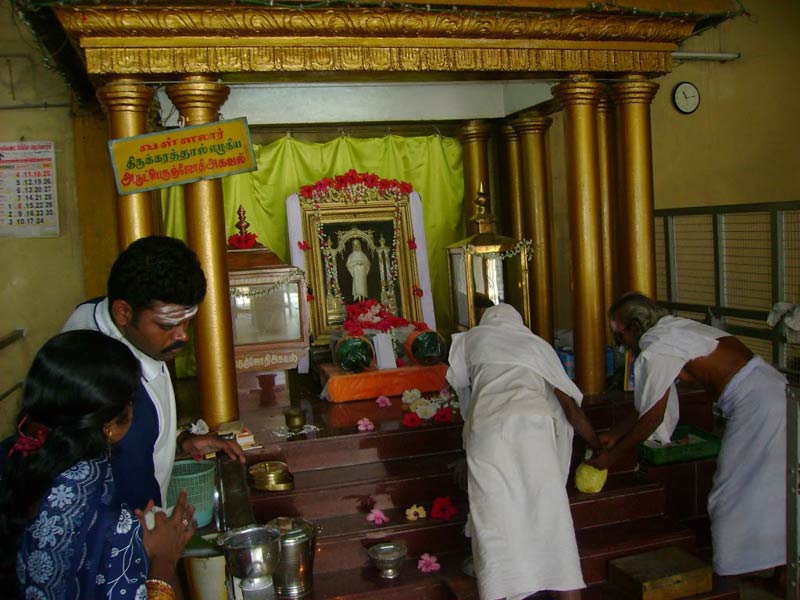
Many visitors crowded in Vadalur, not only to listen to him but also to witness his miracles, which he didn't perform for his own convenience but only when they were necessary. Ramalingam also founded a movement around the same time, giving it the name of Samarasa Suddha Sanmarga Sathya Sangam.
He detested the widespread acceptance of eating meat, to the extent that a simple look from him was enough to turn thousands of people into vegetarians. With vehemence, he condemned the sacrifice of animals for meat, saying that although one might possess notable powers, he could not be called a saint if he had a propensity for eating meat.
Along the night, he meditated and composed hymns and poems. In 1867, his first disciple (Velayutha Mudaliar) published, with his permission, a collection of all of them with the title of Thiru Arutpa (Divine Song of Grace). It was divided into various chants, which are an exposition of celestial God's secrets for the universal benefit of all souls.
English rendering of Thiru Arutpa

The following is a summary of Thiru Arutpa:
| To know God’s truth “SUTHA SANMARGAM” | ||
|---|---|---|
| I | Discipline by fulfilling: | |
| a) | Good character in your relations (nar kunam) | |
|
||
| b) | Good action in your relations (nar ceykai) | |
|
||
| c) | Good qualities in your relations (cupa kunam) | |
|
||
| II | Compassion (visara sangalpam) by inquiring: | |
| 1 | Kalpa - proper practice | |
| 2 | Vikalpa - distinction of knower, knowing, and known | |
| 3 | Sankalpa - to gain experience within | |
| 4 | Savikalpa - the attention and the life force are switched off from the senses and are consciously kept identified with the ever-joyous Spirit. | |
| 5 | Nirvikalpa - a mergence of mental activity (cittavṛtti) in the Self, dissolving distinctions as waves vanish in water. | |
| III | To become a simple man | |
He did long fasts, eating little once every two or three days. He had extraordinary capacities and was accustomed to disappear for some days and nobody was capable of knowing his whereabouts. Was kind, simple and sincere. Not being satisfied on having attained the divine state described in his poems, he begged in delirious ecstacy to the divine so that the Grace may flow even more and more. He asked the divine to help him with the state of Gathi, a state of permanent non breathing with full body function. His aspiration to be melted with the Self turned out to be fulfilled at last. He said: "My entire body emanates a fragrance of camphor like testimony of my Union with the Beloved, the Omnipotent". (A similar story goes around with Vishudhananda who also attained the non breathing state after which his whole body started to smell like flowers and that also became the starting point of the Pranava Deham state as Vallalar called it)
In 1870 finally he was settled in the village of Mettukuppam, three miles to the south from Vadalur, living in a hut known as Siddhi Valaga Thirumaliga (Sacred Mansion of Miracle).
In the second half of 1873 he started up the Movement Samarasa Suddha Sanmarga Sathya Sangam, giving collectively to those present the Mahamantra "Arut Perun Jothi" (according to God himself had been given it to him). He exhorted his disciples to pray God begging for the Eternal Bliss and meditate in the God of the Light settled in their hearts. Before the end of that year he removed the lamp that he had been using and asked his devouts for maintaining it and always keep the light burning, worshipping it as the same God's Form. But he was saddened because his spiritual Mission had not taken root as it should.
Thursday January 30th, 1874 was a very auspicious day because Poosam star would be found ascending at midnight. Having completed already 50 years of his lifetime, Ramalinga sat down on a wood platform speaking to his devouts: "My beloved, I am going to be away for a time. Don't worry. Maintain always this burning lamp, considering it as the same God. You'll be extensively rewarded. Now I'm in this body but soon I'll enter all the bodies of Creation. Close the door and shut it with the padlock outside. When you open it again, the room will be found entirely empty". He said goodbye to those present and was locked in his room. Some time later, on having opened the door, there was not any trace of Ramalinga in the room, he had disappeared dematerializing his body.
It caused a great commotion. The police investigated exhaustively, registering to the utmost the hut without finding anything that lead them to have the smallest suspicion. It was concluded that truelly he was a Saint, considering his disciples that his Total Union with God was realized. According to previous Ramalinga's declarations, this should have signified that he has assumed the dematerialization as the sacrifice of his immortal body, for the disintegration and dispersion of the substances and elements that composed it like seed sown on the field, to make accessible to the human the realization of immortal body and also bring the Universal Manifestation of the Divine.

Siddhi Valaga Thirumaliga.

When entering the village of Mettukuppam, you have an option of going to the left where Vallalar made water appear in dry land (Tinjsuvai Thannir Odaiku Chellum Vawri) and to the right, the place where he attained the state of rainbow body of great transference - Gnana Deham on January 30, 1874 (Sidhivalaku Tirumanikaikku Sellum Vewri).



Vallalar temple next to the water.
Nevertheless, he continued going to Vadalur to meet his disciples. One day he declared his wish to build a temple, requesting his devotees to raise it in six months, according to a design made by himself. That place, called Gnana Sabai, was inaugurated on January 25, 1872. In its interior, there are seven curtains (representing the veils of ignorance) that hide a showcase (the pure soul), in whose interior burns a flame - kundalini - (the eternal splendor of the soul melted with the Supreme Grace Light - Arut Perun Jothi). There should not be any type of rituals practiced inside this temple except the simple burning of camphor. From the time in which the foundation stone of Gnana Sabai was placed, Ramalinga took for custom to stay isolated in his hermitage (the hut) for several days in a row.
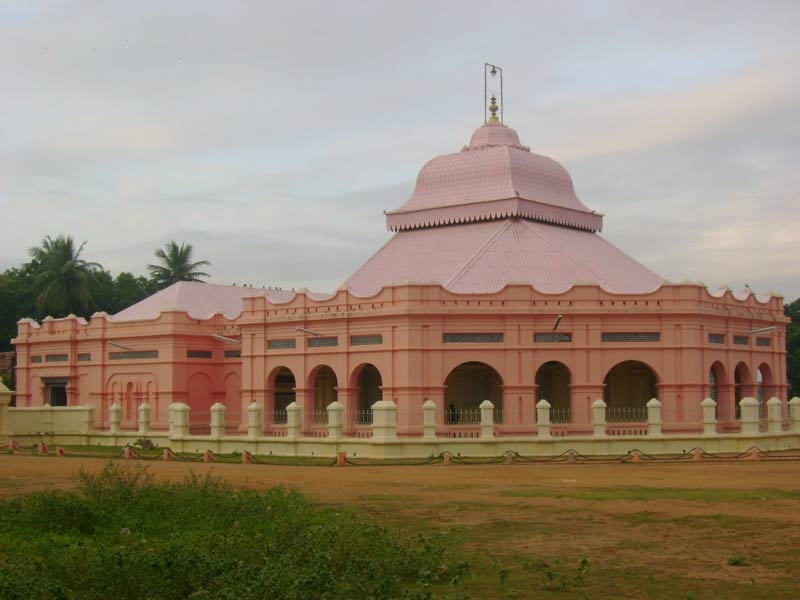
Gnana Sabai
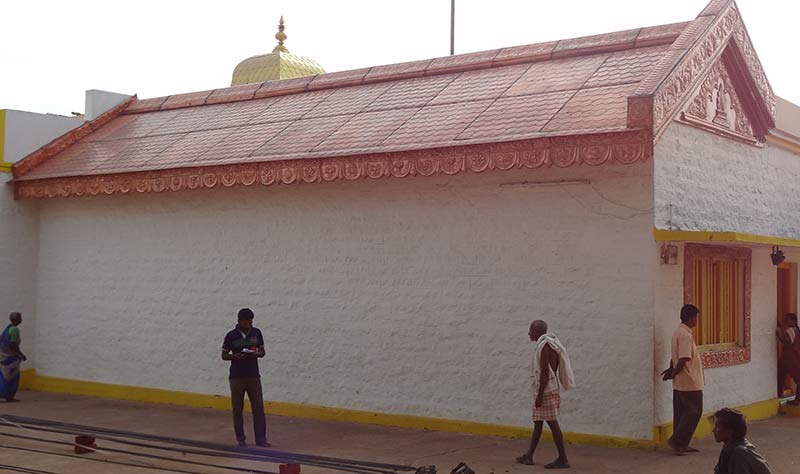


So from understanding Vallalar's life history and visiting all the places where he has been, it became clear to me that he was very much accustomed to advaita (self-inquiry style) and kundalini (as depicted by the ever-burning flame of light in all the Vallalar temples). These were the tools that brought him to the point of non-breathing (nirvikalpa samadhi but then fully functional). Interestingly enough, these techniques are the exact same techniques that the Dzogchen Buddhists use to attain the rainbow body states called Ati Yoga and Togal.

